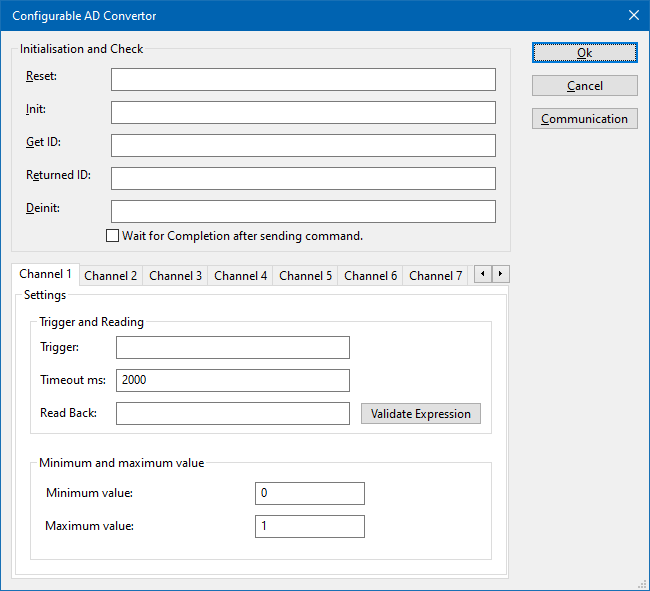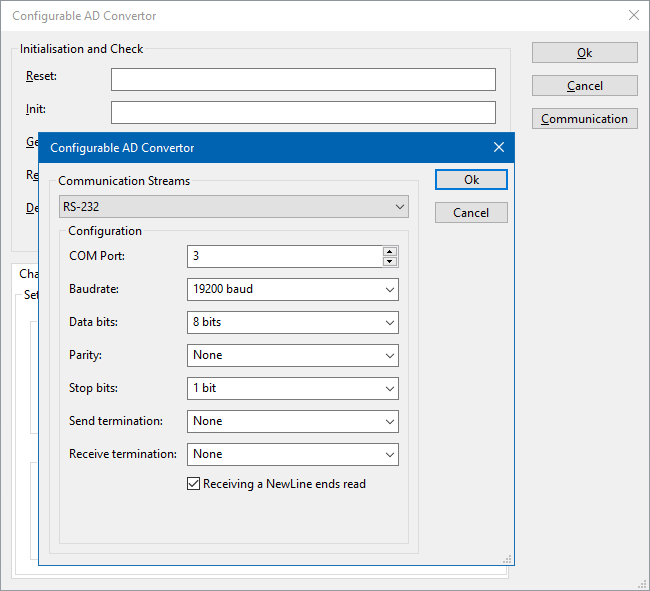Difference between revisions of "Configurable AD Convertor"
(→Channels) |
(→Trigger and Reading) |
||
| Line 43: | Line 43: | ||
For more possibilities see the example section. | For more possibilities see the example section. | ||
}} | }} | ||
| − | {{ScreenElementDescription|Validate|Shows a | + | {{ScreenElementDescription|Validate Expression|Shows a window where the expected output of the measurement device and a regular expression can be typed. The result of the interpretion will then automatically be shown. This window can be used to test the regular expression, to determine if the expected response results in the desired value.}} |
==== Minimum and maximum value ==== | ==== Minimum and maximum value ==== | ||
Revision as of 12:04, 18 September 2017
The Configurable AD Convertor device driver is a AD Converter which is supported by RadiMation®. It can be used to control other measurement equipment, for which no RadiMation device driver is available yet. The Configurable AD Convertor allows to retrieve a measurement value from the measurement equipment, where the measured value can then be used in RadiMation as an EUT Monitoring input. These values can thus be measured and shown in graphs during immunity tests.
Contents
Communication
Multiple communication types can be selected for the configurable AD convertor. Depending on the connection that is used, select the correct Communication Stream, and configure the parameters correspondingly.
Initialisation and Check
| The reset code that needs to be send to device. When left blank, no command will be send. |
| The command that is send to initialize the configured device. When left blank no command will be send. |
| The command that is send to retrieve the ID of the device. This is used to check if the device is connected. A commonly used SCPI command is: *IDN?. When left blank, no command will be send. |
| The identifier is used to check if the correct device driver is selected and the device is connected. Leaving this blank, will skip the device check. |
| The checkmark can be enabled so RadiMation® will wait for all the commands to complete, before it continues. This is done by sending SCPI command *OPC? to the device. |
Channels
AD convertors can have multiple channels on which AD values could be read. For each AD channel, individual commands can be set.
Trigger and Reading
| A trigger command can be specified to request a measurement from the device. A commonly used SCPI command is: *TRG. When left blank, no command will be send. |
| Different measurement devices will return different messages that contain the measurement value. The configurable AD convertor only need the numeric value of the measurement devoce response. The text that is specified in the Read Back box, is used as a regular expressions to determine the returned value.
A good regular expression for finding the first number in scientific notation in a text is: ([+-]?[0-9]*\.?[0-9]+([eE][+-]?[0-9]+)?) For more possibilities see the example section. |
Minimum and maximum value
The minimum and maximum must be set to calculate the raw AD convertor value to a digital value with a specific type.
| The lowest value that can be measured with this device. The value must be the same as filled in the EUT window. |
| The highest value that can be measured with this device. The value must be the same as filled in the EUT window. |
With minimum set to 0 and maximum set to 1, the raw value wont be converted, but instead directly used.
Read Back examples
Received information
|
Regex
|
RadiMation Readout
|
Note
|
|---|---|---|---|
| U_L_N 325 | (-?[0-9.,Ee-]+)
|
325
|
Takes the first number.
|
| I_L1;12.34 | ;(-?[0-9.,Ee-]+)
|
12.34
|
Takes the first number after ";".
|
| THD_U_L1;;14,5 | ;;(-?[0-9.,Ee-]+)
|
14.5
|
Takes the first number after ";;".
|
| AC_FREQ;Channel1;1.23E3 | ;*;(-?[0-9.,Ee-]+)
|
1230
|
Takes the first number after the appearance of a second ";".
|
The regular expressions can always be tested trough the Validate Expression function.

